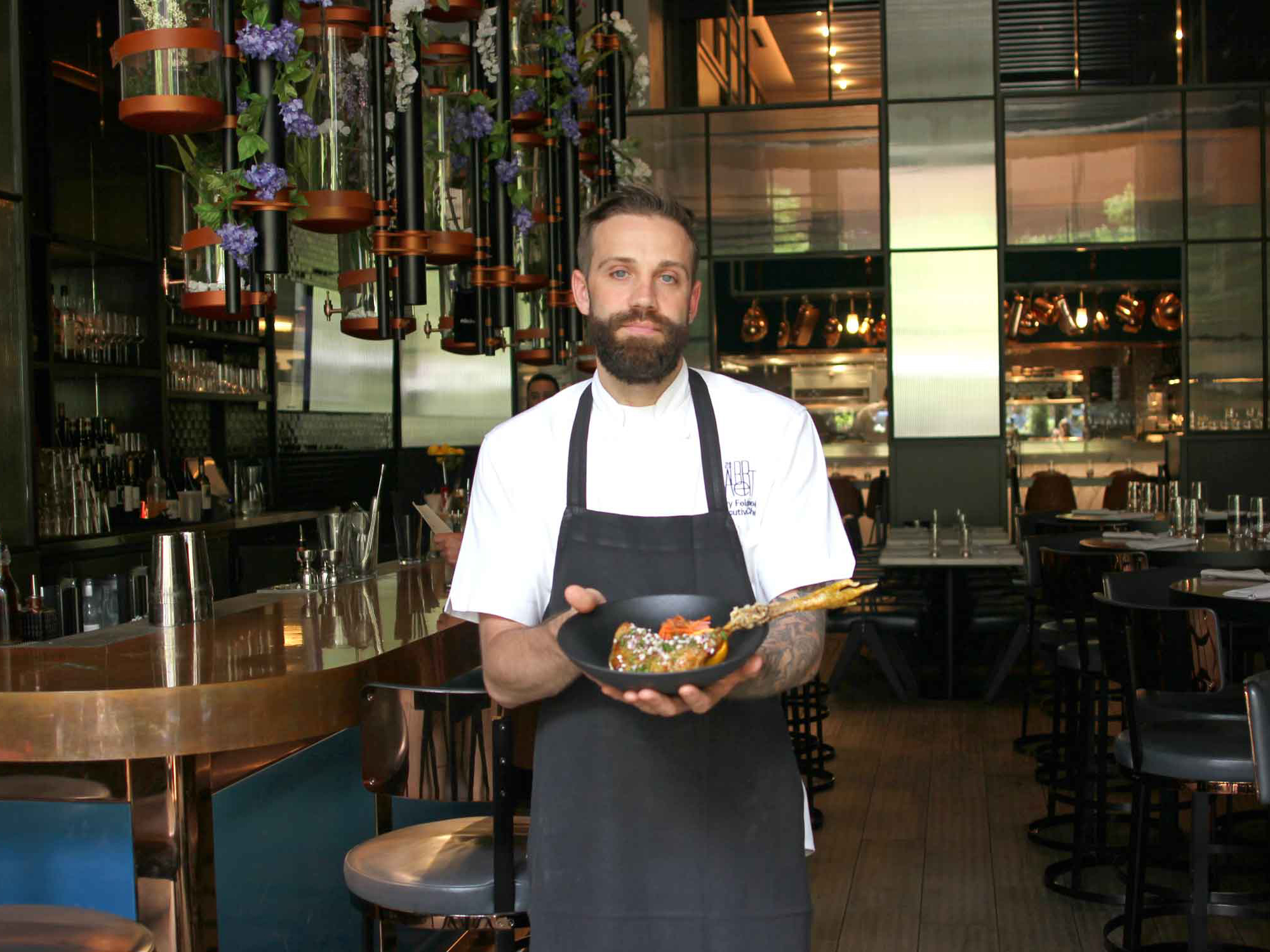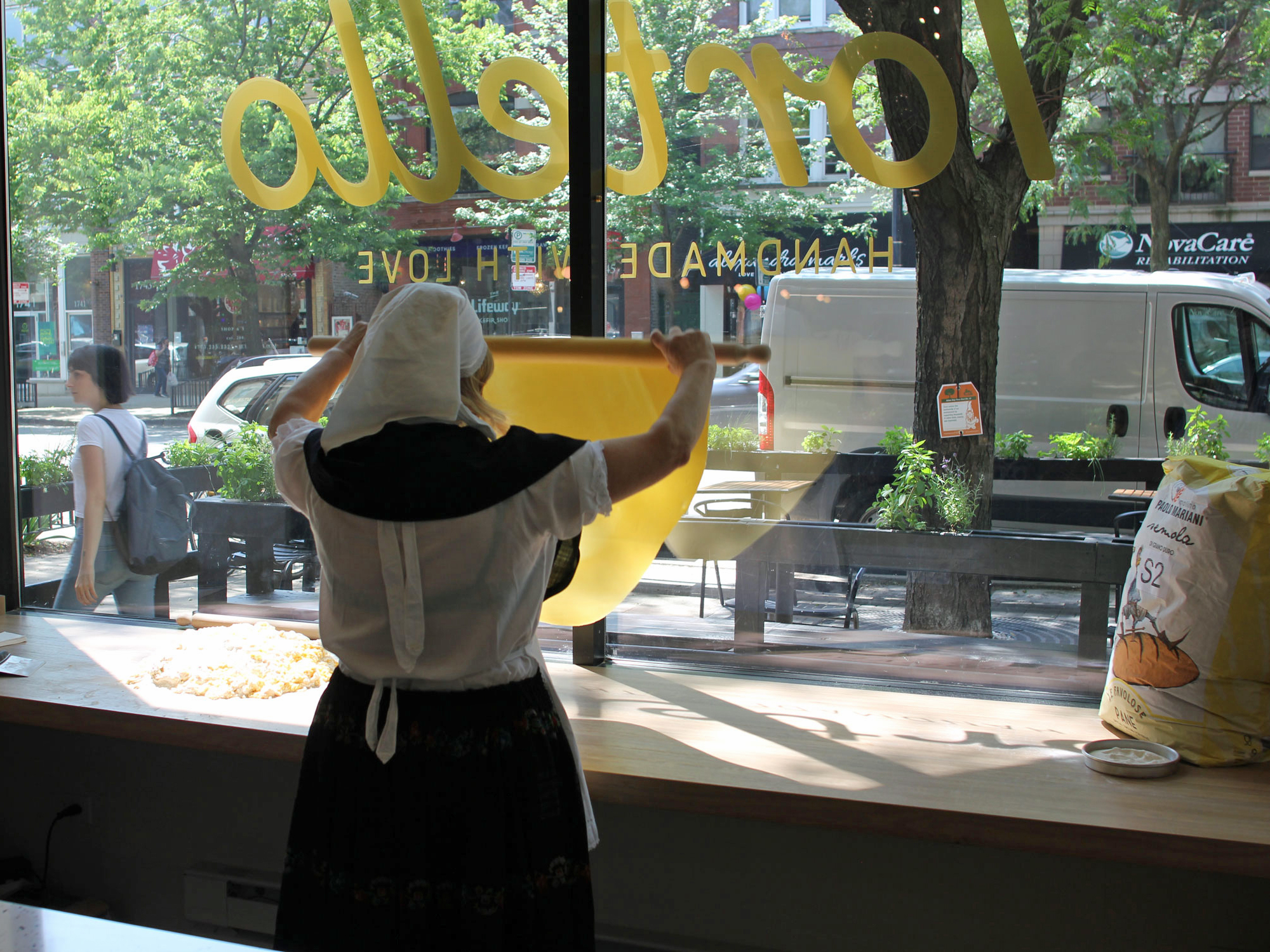TAKE THE FALAFEL. Six of them sit neatly on a plate, each one with a crispy brown exterior, the crust over a tender, bright green inside which gives off intense whiffs of cooked parsley. But they’re not balls of falafel—they’re shaped more like little grassy doughnuts. I ask if the hole in the middle means they get cooked on a skewer.
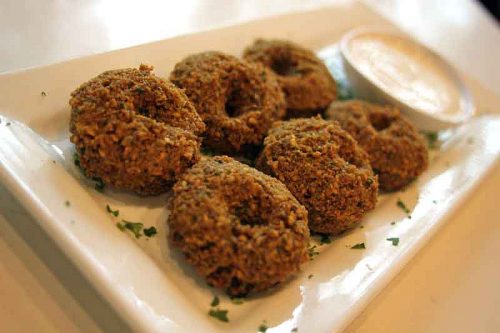
“No, no. It serves two purposes,” says Osama Aldawud, general manager of the restaurant, Oozi Corner in south suburban Bridgeview. “It’s so they get cooked all the way on the inside, and also, design-wise, it looks a little bit better. A lot of restaurants, they serve them when it’s too thick, and they’re still kind of doughy in the middle. This makes sure the heat reaches all the areas.”
In other words, they’ve been optimized. Different shapes have been tested, and the toroidal shape has been determined to produce the best result.
Oozi Corner didn’t invent doughnut-shaped falafel—at least, I feel like I’ve seen them before. But what sets this relatively upscale Mediterranean restaurant apart from the mom and pop spots that these restaurants often are, is that it is run as a modern corporate business, taking superior ideas it finds around the world to produce the best and most efficient product in its category.
A recent article on middle eastern food having a moment in more upscale locales and venues concentrated on celebrated chefs (Galit), and restaurant groups in chic neighborhoods (Aba, Ema). But it’s just as possible that one of the ones who brings it to more of America will be this soon-to-be-chain, which launched in March, out of sight to the mainstream Chicago food scene—for now.
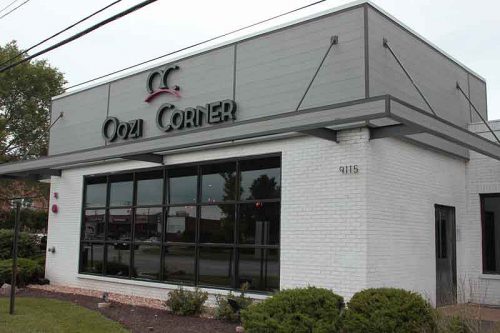
9115 S. Harlem
BRIDGEVIEW IS STRAIGHT SOUTH ON HARLEM past the city’s border, past what used to be Toyota (now SeatGeek) Park for the Chicago Fire soccer team, past Haunted Trails, where a miniature golf Frankenstein looms over Harlem Avenue. (The golf is miniature, the monster is oversized.) The best middle eastern eating neighborhood in the Chicago area is not immediately apparent amid Mexican and Greek choices, and Oozi Corner, at 91st and Harlem, looks about the size of a Wendy’s, complete with drive-through, from the street.
That view’s deceptive, though, as you see when you go inside. To the right is a cafe area, with an open kitchen, cases full of middle eastern desserts along the lines of baklava, heavy on honey and nuts. To the left is a very attractive lounge area—the word “lounge” suggested by the music, which is less middle eastern souk than airport piano bar—with black leather booths and potted trees. It’s the first place in the area that really suggests the better-financed Arab restaurants and sweets shops in Dearborn, Michigan—and true to the image, a group of women in stylish hijab is celebrating a 30th birthday in one of the rooms, complete with metallic balloons and a rendition of “Happy Birthday” with cymbals and drums.
The menu calls it “Hybrid Mediterranean,” and I understand what that means as soon as I try to pin down which particular nationality it represents. The Bridgeview Arabic population is mostly Jordanian/Palestinian, a community that started in the South Loop before World War I and later moved to Chicago Lawn around 63rd street, before heading to the burbs like so many other groups. Yet the menu has Turkish coffee and Arabic coffee as distinct offerings; I can see shawerma on spits (typical of the Levant, e.g., Syria, Lebanon) and yet the menu also has stews baked in clay pots, which suggests Morocco. Hummus in Bridgeview is invariably in the Jordanian style, heavy on tahini—yet Oozi’s isn’t.
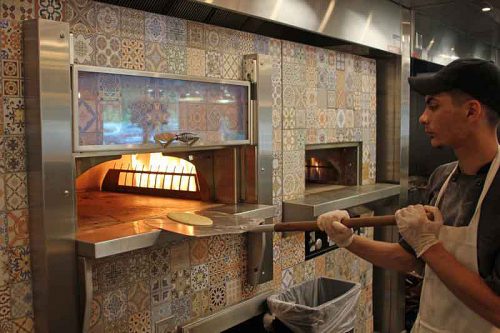
Pita go in a woodburning oven
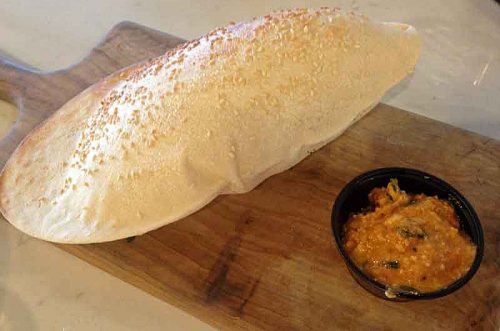
A type of puffed pita, served with a complimentary red pepper-feta dip
Dawood explains that Oozi Corner was started by investors and a management team from Syria and Saudi Arabia, with the intention of offering a kind of all-purpose Mediterranean cuisine. “Basically our business plan was to be diverse in the type of food that we serve. So we kind of blend in several different styles—a little bit of Turkish, Syrian, Jordanian, Palestinian, Lebanese, even a little bit of Moroccan. Even a little bit of the gulf region. We try to have as many flavors as we can, so our customers don’t miss out on one flavor.”
The name Oozi comes from a popular banquet dish also known as qoozi or quzi—”It’s known in most of the countries, but each country has a different concept of it,” he says. “The Syrian style is the oozi sack, a sack of dough that you stuff the chunks of lamb, rice and green peas in. On the Jordanian-Palestinian side, or even the gulf side, they make the oozi the same way, but without the dough sack,” on a platter. At Oozi Corner, they do it Syrian style, in a dough shell. “It’s all the same flavor, just different ways of serving it.”
Dawood is a restaurant industry veteran who had previously opened two other restaurants in the south suburbs, including Fattoush in Worth, which has a similar something-from-everywhere approach to middle eastern food. At first that might seem a recipe for corporatized mediocrity, every dish reduced to its most inoffensive version. There are middle eastern chains like that (especially in the Loop).
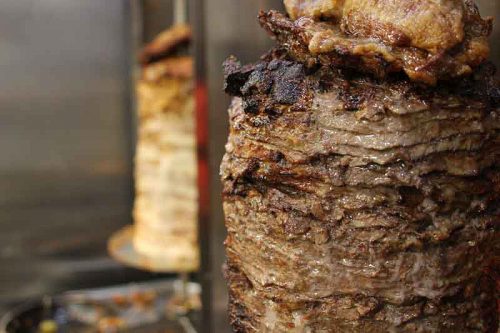
Shawerma cones
But Oozi is not one of them. What strikes you as you look around the kitchen area, and as you try the food, is that they’ve sought out the best version of each dish—and invested heavily in the equipment to do it right. Pita go into a Neapolitan pizza oven and come out fresh, hot and as puffed up as a blowfish, like they do at Galit. Shawerma rotates on a spit in front of a gas fire, crisping and caramelizing beautifully. Skewers of meat cubes rest on top of a charcoal pit sized exactly wide enough for the metal spears, like they do at Al-Bawadi and a few other restaurants in Bridgeview but almost nowhere else in Chicagoland. There’s not a category on the menu I can think of where Oozi wouldn’t make the top three, at least, in Chicago.
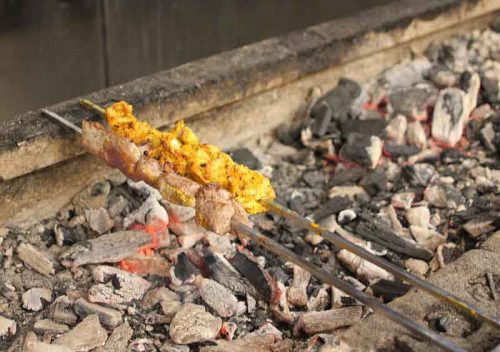
Meat over a charcoal grill built just wide enough for skewers
Dawood says they looked at each item on the menu and asked, “What’s the favorite style, which one has the highest rating for hummus,” and so on down the line. “Other restaurants in the area serve a similar style, we want to go to what’s known to people the most.” One example of how seriously they take the classic foods of the region is visible in the express/cafe area as you enter the restaurant. Knafeh is a traditional dessert, a sweet cheese baked with a crust of pastry dough or shredded wheat on top. Typically in Bridgeview you see it in a big sheet pan, cut and warmed to order and served with a sweet syrup ladled over it.
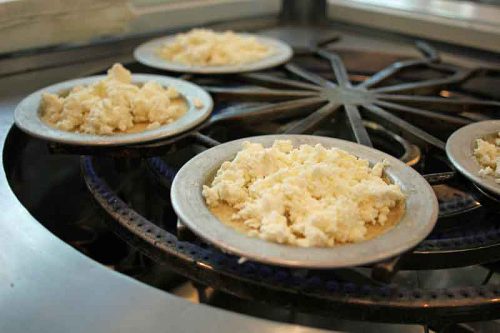
Knafeh on a special knafeh grill, which bakes the crust and warms the cheese
Not here. Each serving is prepared individually in a little tin pan filled with the dough and refrigerated. (The dough is made in-house by another machine in the back.) A cook takes it out of a cooler as ordered, sprinkles the cheese on top and sets it on a special knafeh cooker made in Turkey.
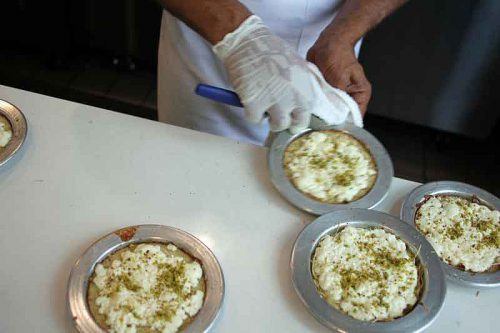
The cooked knafeh is sprinkled with ground pistachios
After a few minutes, it’s flipped onto a plate and served with the syrup and ground pistachios—the freshest knafeh in Chicago.
All this machinery hints at something else about the way Oozi Corner is run like a corporate business and not a mom and pop restaurant—namely, that it’s built on systems, not on any one chef, even as the CEO himself comes from a pastry chef background. Dawood is well aware of the typical fate of the small middle eastern restaurant—that it’s good as long as the good chef stays, and when he gets lured away, it goes downhill. “With our twenty years of experience in the industry, we were fully aware of that,” he says. “Prior to opening, we established our recipes, established the flavor, established the system. And basically, if you bring in anybody who has a little background of cooking, they can be a chef here. This is a non-chef operation.”
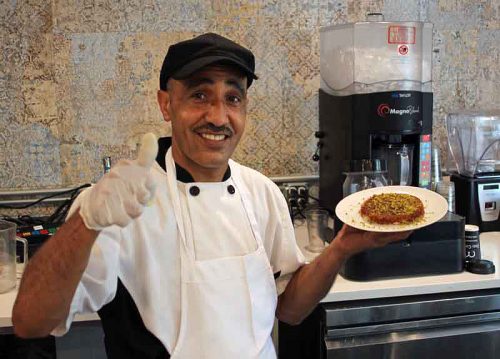
Then it’s flipped onto a plate, ladled with a sweet syrup and sprinkled with more pistachios
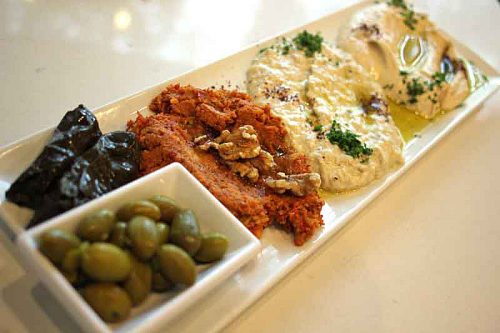
Meze sampler with stuffed grape leaves, muhammara, baba ghanoush and hummus
IT’S 22 MILES FROM MY HOUSE TO Oozi Corner, so assuming something similar for most people in the Chicago area, I understand if you’re questioning whether it’s really worth that kind of drive for a cuisine widely available around town. Fortunately in that case, you will soon have another choice. Dawood tells me about many different things they have in the works—for instance, they’ll soon do a bit of table showbiz I had in central Turkey, a stew cooked inside a clay pot which is broken open at the table to pour out the finished dish.
But the main thing they have in the works is their second location—somewhere downtown. The goal is to bring workers in the downtown area middle eastern food on a level they’ve not had it before. Part of that is a menu that skews more to the fast casual dining needs of people on lunch break. But it also means an area of grocery items—in Bridgeview there’s a small section of quality items in jars and boxes for sale, but downtown, he says, will have a full array of middle eastern products chosen for high quality. “It’s a lovely idea that brings color to the place. People walk in, see things that they’d like to have, after they try the spices here. I think this area will work even better downtown, because we’re going to be even heavier on the grocery section. We’re going to be selling a lot of Mediterranean and even American spices and products,” Dawood says.
Another thing in the works for downtown suggests that they took a page from Eataly, where the first area you walk into offers gelato and other sweets. The downtown location will offer Turkish ice cream, served up in a window facing pedestrians. Okay, what’s the big deal about that, you ask? If you’ve been to Istanbul, you’ve probably seen vendors on the street, offering the Turkish ice cream known as dondurma, made with mastic gum (a derivative of the orchid plant) which makes for a uniquely sticky and stretchy ice cream. (He’s actually the second one in Bridgeview to mention bringing dondurma to Chicago to me—the owner of the Al-Amal Bakery & Grocery on 87th is also working on an ice cream shop in the strip mall he’s in.) It’s a great show that will probably be what first lures many into the restaurant and market when it opens.
“You’re going to see a lot of things you haven’t seen before,” he says.
Beyond downtown Chicago, Dawood says they hope to prove and refine the concept to where it could open in big cities across America, and beyond. “Our vision is to be known worldwide,” he says. “We want to reach everybody—we don’t believe in just serving one ethnicity. Our policy is to be very diverse, in customers and hiring.”
Which raises a question—if that’s the case, why start with a tough crowd like the Arab-Americans in Bridgeview, who have plenty of other choices and an experienced, critical eye for the cuisine? (It’s not like downtown Chicago has been an especially demanding audience for sort-of-middle-eastern fare.)
“We started down here because this area has been known to serve this type of cuisine,” he says. “So we wanted to branch out from here. To show the people who are overseas and know the real taste, that we are the real deal.”
Michael Gebert is the Head Fez of Fooditor.
A Fooditor hat tip to Rob Gardner, who ate there first.
Latest
Join the Discussion
After you comment, click Post. If you're not already logged in you will be asked to log in or register with Disqus.





